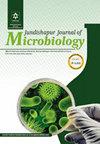医院感染产β -内酰胺酶的铜绿假单胞菌的基因分型研究
IF 0.5
4区 医学
Q4 MICROBIOLOGY
引用次数: 0
摘要
背景:铜绿假单胞菌医院感染是与患者死亡率和流动性增加相关的主要问题之一。目的:本研究旨在确定从医院感染患者中分离出的产超广谱β-内酰胺酶(ESBL)铜绿假单胞菌基因型的分子流行病学。方法:从三级转诊医院获得146株假单胞菌临床分离株。利用gyrB的表型鉴定和PCR检测对铜绿假单胞菌进行了鉴定。采用纸片近似试验和联合纸片试验(CDT)对样品中的超广谱β-内酰胺酶进行鉴定。用聚合酶链式反应检测blaSHV和blaTEM基因。通过脉冲场凝胶电泳(PFGE)、重复元件序列(Rep)-PCR和肠道细菌重复基因间共有性(ERIC)-PCR方法对菌株进行分型。结果:共分离出134株(91.78%)铜绿假单胞菌,其中41.79%与医院感染有关。超广谱β-内酰胺酶分析显示,分别有5.97%和66.41%的菌株携带blaSHV和blaTEM基因。肠道细菌重复基因间一致性PCR、Rep PCR和PFGE分别显示56、55和55种不同的模式。脉冲场凝胶电泳显示脉冲型C3占优势。结论:ESBL产生、blaSHV和blaTEM阳性与ERIC、Rep-PCR和PFGE模式之间的相关性不显著(P≥0.05)。在医院感染中,伊朗库尔德斯坦省的ESBL产生铜绿假单胞菌分离株的患病率相对较高。建议定期审查铜绿假单胞菌的抗生素耐药性和分子特征,以防止医院感染的传播。本文章由计算机程序翻译,如有差异,请以英文原文为准。
Genotyping of Extended Spectrum Beta-Lactamase-Producing Pseudomonas aeruginosa Isolated from People with Nosocomial Infections
Background: Pseudomonas aeruginosa nosocomial infections are among major problems associated with increased mortality and mobility among patients. Objectives: The aim of this research was to determine the molecular epidemiology of extended spectrum beta-lactamase (ESBL)-producing P. aeruginosa genotypes isolated from patients with nosocomial infections. Methods: One hundred forty-six clinical isolates of Pseudomonas spp. were obtained from a tertiary referral hospital. Phenotypic identification and PCR detection of gyrB were used to characterize P. aeruginosa. Extended spectrum beta-lactamases in samples were identified using the disk approximation test and the combination disk test (CDT). The blaSHV and blaTEM genes were detected by PCR. The strains were typed by the pulse field gel electrophoresis (PFGE), repetitive element sequence (Rep)-PCR, and enterobacterial repetitive intergenic consensus (ERIC)–PCR methods. Results: A total of 134 (91.78%) P. aeruginosa isolates were separated, 41.79% of whom were related to nosocomial infections. The extended spectrum beta-lactamase analysis test revealed that 5.97% and 66.41% of the isolates harbored the blaSHV and blaTEM genes, respectively. Enterobacterial repetitive intergenic consensus PCR, Rep-PCR, and PFGE each showed 56, 55, and 55 different patterns, respectively. Pulse-field gel electrophoresis indicated that pulso types C3 were dominant. Conclusions: The associations between ESBL production, blaSHV and blaTEM positivity, and ERIC, Rep-PCR, and PFGE patterns were not significant (P ≥ 0.05). Among nosocomial infections, a relatively high prevalence of ESBL-producing P. aeruginosa isolates was observed in the Kurdistan province of Iran. Periodic review of antibiotic resistance and molecular characterization of P. aeruginosa isolates is recommended to prevent the spread of nosocomial infections in hospitals.
求助全文
通过发布文献求助,成功后即可免费获取论文全文。
去求助
来源期刊

Jundishapur Journal of Microbiology
MICROBIOLOGY-
CiteScore
1.30
自引率
0.00%
发文量
56
审稿时长
6-12 weeks
期刊介绍:
Jundishapur Journal of Microbiology, (JJM) is the official scientific Monthly publication of Ahvaz Jundishapur University of Medical Sciences. JJM is dedicated to the publication of manuscripts on topics concerning all aspects of microbiology. The topics include medical, veterinary and environmental microbiology, molecular investigations and infectious diseases. Aspects of immunology and epidemiology of infectious diseases are also considered.
 求助内容:
求助内容: 应助结果提醒方式:
应助结果提醒方式:


